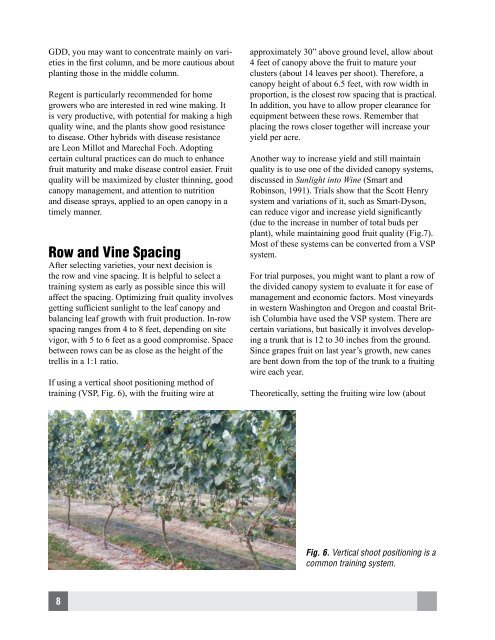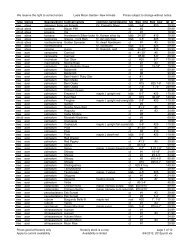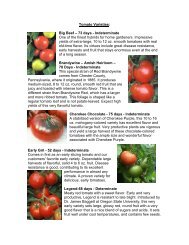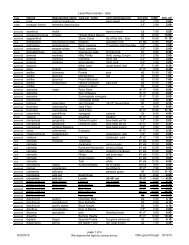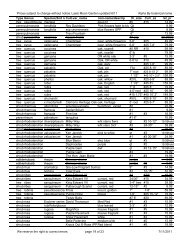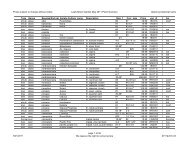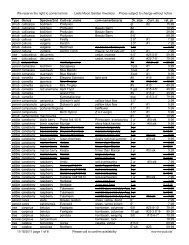Wine Grapes for Western WA EB 2001 - Laels Moon Garden Nursery
Wine Grapes for Western WA EB 2001 - Laels Moon Garden Nursery
Wine Grapes for Western WA EB 2001 - Laels Moon Garden Nursery
Create successful ePaper yourself
Turn your PDF publications into a flip-book with our unique Google optimized e-Paper software.
GDD, you may want to concentrate mainly on varieties<br />
in the first column, and be more cautious about<br />
planting those in the middle column.<br />
Regent is particularly recommended <strong>for</strong> home<br />
growers who are interested in red wine making. It<br />
is very productive, with potential <strong>for</strong> making a high<br />
quality wine, and the plants show good resistance<br />
to disease. Other hybrids with disease resistance<br />
are Leon Millot and Marechal Foch. Adopting<br />
certain cultural practices can do much to enhance<br />
fruit maturity and make disease control easier. Fruit<br />
quality will be maximized by cluster thinning, good<br />
canopy management, and attention to nutrition<br />
and disease sprays, applied to an open canopy in a<br />
timely manner.<br />
Row and Vine Spacing<br />
After selecting varieties, your next decision is<br />
the row and vine spacing. It is helpful to select a<br />
training system as early as possible since this will<br />
affect the spacing. Optimizing fruit quality involves<br />
getting sufficient sunlight to the leaf canopy and<br />
balancing leaf growth with fruit production. In-row<br />
spacing ranges from 4 to 8 feet, depending on site<br />
vigor, with 5 to 6 feet as a good compromise. Space<br />
between rows can be as close as the height of the<br />
trellis in a 1:1 ratio.<br />
If using a vertical shoot positioning method of<br />
training (VSP, Fig. 6), with the fruiting wire at<br />
approximately 30” above ground level, allow about<br />
4 feet of canopy above the fruit to mature your<br />
clusters (about 14 leaves per shoot). There<strong>for</strong>e, a<br />
canopy height of about 6.5 feet, with row width in<br />
proportion, is the closest row spacing that is practical.<br />
In addition, you have to allow proper clearance <strong>for</strong><br />
equipment between these rows. Remember that<br />
placing the rows closer together will increase your<br />
yield per acre.<br />
Another way to increase yield and still maintain<br />
quality is to use one of the divided canopy systems,<br />
discussed in Sunlight into <strong>Wine</strong> (Smart and<br />
Robinson, 1991). Trials show that the Scott Henry<br />
system and variations of it, such as Smart-Dyson,<br />
can reduce vigor and increase yield significantly<br />
(due to the increase in number of total buds per<br />
plant), while maintaining good fruit quality (Fig.7).<br />
Most of these systems can be converted from a VSP<br />
system.<br />
For trial purposes, you might want to plant a row of<br />
the divided canopy system to evaluate it <strong>for</strong> ease of<br />
management and economic factors. Most vineyards<br />
in western Washington and Oregon and coastal British<br />
Columbia have used the VSP system. There are<br />
certain variations, but basically it involves developing<br />
a trunk that is 12 to 30 inches from the ground.<br />
Since grapes fruit on last year’s growth, new canes<br />
are bent down from the top of the trunk to a fruiting<br />
wire each year.<br />
Theoretically, setting the fruiting wire low (about<br />
Fig. 6. Vertical shoot positioning is a<br />
common training system.<br />
8


